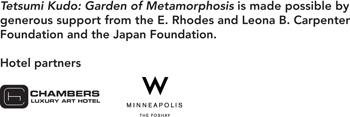Tetsumi Kudo: Garden of Metamorphosis
Opening October 18, 2008
Minneapolis, Minnesota
Tetsumi Kudo’s room-size installation titled Philosophy of Impotence, a culmination of his early radical performances and installations, stunned the Tokyo art world in 1962 and came to be known as one of the most iconic works in postwar Japanese art history. Tetsumi Kudo: Garden of Metamorphosis, the late artist’s first solo museum exhibition in the United States, premieres at the Walker Art Center on October 18, 2008.
Organized by Walker visual arts curator Doryun Chong, in close collaboration with the artist’s estate, the retrospective exhibition features more than 100 works of diverse media—objects, sculpture, installation, drawing, and painting—covering the entire trajectory of Kudo’s productive career, from the late 1950s through the 1980s, drawn from important collections in Japan, Europe, and the United States. Tetsumi Kudo: Garden of Metamorphosis introduces the artist and his singular body of work to American audiences.
Born into an artistic family, Tetsumi Kudo (1935–1990) belonged to the generation that came of age in the late 1950s, when Japan had emerged from the rubble of World War II and the subsequent American occupation (1945–1952) and was beginning to enjoy rapid economic growth and relative political stability. At the same time, the forced postwar demilitarization and refashioning of society in a pacifist guise left many youths politically disenchanted and intellectually confused.
Although Kudo received a traditional education at the Tokyo National University of Fine Arts and Music, he began, even before his graduation in 1958, to react to the restless social climate. For the abovementioned Philosophy of Impotence he filled an entire gallery in the Tokyo Metropolitan Art Museum with objects that resembled either penises or chrysalises and symbolized the “pathetic despair of human efforts.” Shortly after the exhibition, Kudo headed to Paris and made it his base for the next quarter century. Ever a provocateur, he quickly developed a practice that challenged and critiqued the Western dualistic way of viewing humanity in opposition to nature or technology.
Kudo’s previously abstract work grew figurative, and his increasingly lurid, even morbid and grotesque objects began incorporating sculptural fragments of the human body—face, hands, brain, penis, skin—inside bird cages, fish tanks, and wooden boxes, in which he also often included found everyday objects. Calling these works Your Portrait, the artist declared, “I wanted to tell Europeans that humanism and love and sex are virtually on the same dimension as such mundane commodities as instant soup or cigarettes.”
Kudo’s diagnosis of the ills and contradictions of the uncontrollable consumerism and the technologization of postwar society gradually evolved into another idiosyncratic, artistic vision of symbiosis between humans and nature, which they have irreversibly polluted, and between humans and the technology that infiltrates and dominates their lives. In the last decade of his life, Kudo sharply shifted the orientation of his art, turning away from belligerent confrontation to a more self-reflective stance toward his own identity, origin, and culture. His work grew less visceral and more abstract and contemplative.
While Kudo’s art and vision were consistently and uniquely transcultural, international, and cosmopolitan, he remained, in his private thinking and public persona, an eternal outsider. As an artist, he exuberantly explored forms and colors and invented a strikingly eccentric visual vocabulary that gave, and still gives voice to, complex contemporary human conditions.
The exhibition is accompanied by a fully illustrated 304-page catalogue, featuring writings by Doryun Chong, Hiroko Kudo, and Mike Kelley and also including a number of the artist’s statements, manifestos, and interviews, many of them translated into English for the first time.
For further information on the Walker Art Center visit walkerart.org or call 612.375.7600.



